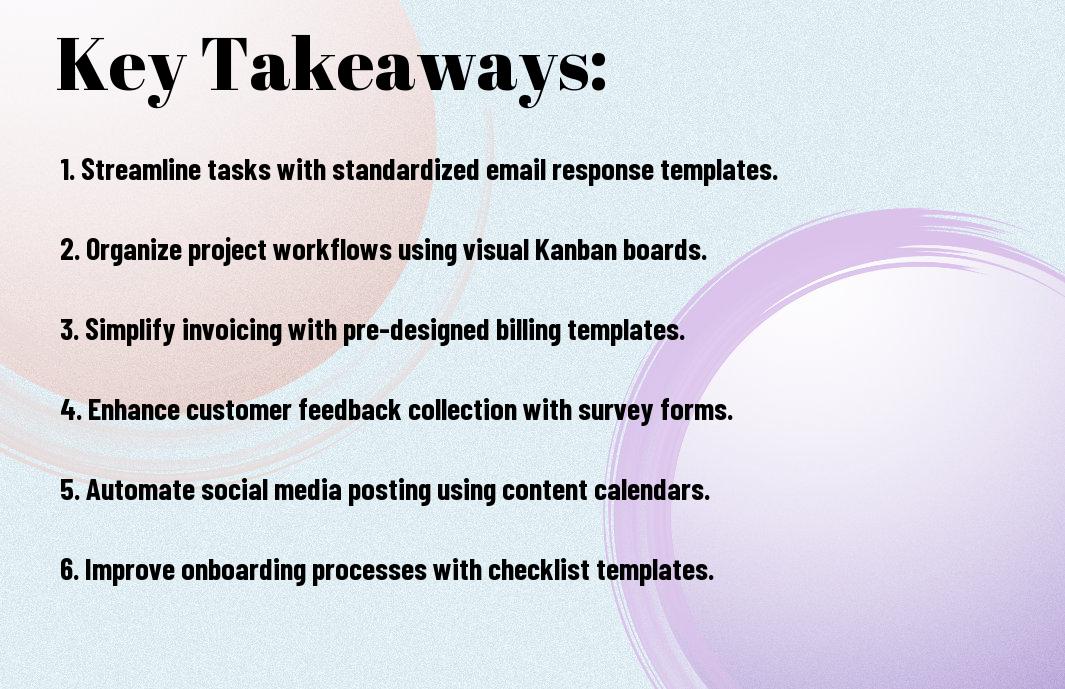Templates can streamline your workflow and enhance productivity in your business processes. In this post, you’ll discover five vital templates that will help you automate tasks efficiently, saving you time and resources. By implementing these strategies, you’ll be able to focus on what really matters: growing your business. For more insights, check out Five Important Automations to Implement Into Your Business that can further guide you in your automation journey.
Key Takeaways:
- Automation templates can significantly streamline repetitive tasks, saving time and reducing errors.
- Choosing the right templates tailored to specific business needs enhances efficiency and productivity.
- Integrating automation into existing workflows can improve collaboration among team members.
- Templates should be flexible and adaptable to accommodate changes in business processes.
- Starting with basic templates allows beginners to learn and gradually implement more complex automation solutions.

Understanding Business Automation
A quick grasp of business automation can revolutionize your operations. By streamlining repetitive tasks through automated systems, you can enhance efficiency and focus your resources on growth. To dive deeper into the world of automation, check out 15 Essential Marketing Automation Email Templates for 2025.
What is Business Automation?
Behind every successful business process lies automation, which involves using technology to perform tasks that were once manual. This can include everything from automated emails to scheduling, ultimately reducing errors and saving time.
Benefits of Automation for Beginners
For beginners, automation can simplify your workflows and enhance productivity. By automating repetitive tasks, you free up your time and allow for more focus on strategic initiatives and growth.
With automation, you can minimize human error, decrease operational costs, and improve overall efficiency. This not only enhances your ability to deliver value to customers but also allows you to scale your business operations as you grow. Embracing automation early on sets a strong foundation for future success and adaptability in a competitive landscape.

Template 1: Workflow Automation
While implementing workflow automation can significantly enhance your business efficiency, it’s imperative to understand its framework and how it applies to your specific processes. By streamlining repetitive tasks and coordinating different aspects of your operations, workflow automation helps you focus on higher-value activities, ultimately boosting productivity and minimizing errors.
Defining Workflow Automation
At its core, workflow automation refers to the use of technology to streamline and automate routine processes within your organization. This typically involves creating a structured sequence of tasks that are triggered by specific events, allowing you to eliminate manual steps and optimize overall workflow efficiency.
Implementing Workflow Automation
Any business can benefit from implementing workflow automation by identifying key processes that can be streamlined. Begin by mapping out your current workflows, pinpointing bottlenecks, and assessing areas where repetitive tasks can be automated for better output.
To successfully implement workflow automation, you should start by selecting the right tools that align with your business needs. After identifying processes to automate, integrate those tools into your existing systems while ensuring that your team is adequately trained in their use. Monitor the performance of your automated workflows and make adjustments as needed to optimize efficiency and effectiveness over time.
Template 2: Email Marketing Automation
Many businesses overlook the power of email marketing automation, which can significantly streamline your communication efforts. By using automated templates, you can ensure that the right messages reach your audience at the right times, increasing both engagement and conversions.
Importance of Email Marketing
After establishing your business, building a reliable customer base is crucial. Email marketing allows you to maintain direct communication with your audience, nurture relationships, and provide valuable content that keeps your brand top-of-mind.
Setting Up Automated Email Campaigns
Marketing automation enables you to create tailored email campaigns that trigger based on user behavior. This means you can send welcome emails, follow-up messages, and promotional offers without manually crafting each message.
In addition, setting up automated email campaigns requires identifying key customer touchpoints and designing emails that resonate with your audience. You should segment your contacts based on their interests and behaviors to ensure your message is relevant and engaging. With user-friendly tools available, you can schedule and personalize your campaigns, all while tracking their performance to make necessary adjustments and improve results.
Template 3: Customer Relationship Management (CRM) Automation
Despite the ever-increasing competition in the market, leveraging CRM automation can significantly improve your business’s efficiency and customer satisfaction. By utilizing a well-structured CRM template, you can streamline interactions, manage customer data, and enhance your overall workflow, allowing you to focus more on building stronger relationships with your customers.
Role of CRM in Business
Along with managing customer interactions, a robust CRM system organizes data, tracks leads, and provides insights, enabling you to make informed decisions. This methodology not only helps in understanding your customers better but also increases retention and fosters loyalty, ultimately contributing to your bottom line.
Automating CRM Tasks
Management of your CRM tasks can become time-consuming, which is why automation is key. By automating routine tasks such as data entry, lead nurturing, and follow-ups, you free up valuable time, allowing you to focus on strategy and growth in your business.
Also, automating these tasks ensures consistency and reduces the chance of errors, improving data accuracy. With automation, you can set up reminders for follow-ups or send personalized emails to clients automatically. This level of efficiency means your team can dedicate more energy to high-value tasks, such as building relationships and closing deals, which are necessary for business growth.

Template 4: Social Media Automation
Keep your business thriving by automating your social media efforts. With the right templates in place, you can efficiently schedule posts, engage with your audience, and analyze performance metrics without spending endless hours on these tasks. Automation not only frees up your time but also helps create a consistent online presence that can enhance your brand’s visibility and interaction.
Benefits of Social Media Automation
The benefits of social media automation are extensive. By automating your posting schedule, you ensure that your content is shared at optimal times, increasing engagement rates. Moreover, it allows you to maintain a steady flow of communication with your audience, even when you’re not actively online. This consistency can lead to stronger relationships with your followers and improved brand loyalty.
Tools for Effective Social Media Automation
Tools for effective social media automation can streamline your efforts and maximize your reach. Numerous platforms, like Buffer and Hootsuite, enable you to schedule posts across multiple channels, track engagement, and analyze your performance in real-time.
For instance, using a tool like Buffer not only allows you to schedule posts in advance but also provides analytics that help you understand which content resonates best with your audience. You can customize your posts for various platforms, ensuring that your messaging is optimized for each. These tools simplify your workflow, enabling you to focus on creating quality content while automating repetitive tasks.
Template 5: Reporting and Analytics Automation
Now that you’re equipped with various automation templates, let’s examine into reporting and analytics automation. This template allows you to streamline your data collection and performance tracking, giving you valuable insights at your fingertips. By automating these processes, you can save time, reduce human error, and make more informed decisions to drive your business forward.
Importance of Analytics in Business
Analytics plays a fundamental role in understanding your business performance. By interpreting data effectively, you can identify trends, uncover opportunities, and make data-driven decisions that enhance your overall strategy. This deep understanding of your metrics allows you to adjust your approach and respond proactively to market changes, ultimately leading to increased profitability.
Automating Reporting Processes
At the heart of automated reporting lies the ability to generate real-time insights with minimal effort. By integrating automation tools, you can schedule reports, gather data from multiple sources, and visualize information without manual intervention. This not only saves time but also ensures consistent reporting intervals, enabling you to focus on analyzing the insights rather than spending time on data collection.
Reporting becomes more effective when you leverage automation tools to seamlessly compile and present information. You can set up dashboards that automatically update with the latest data, allowing you to track key performance indicators in real-time. This efficiency gives you the freedom to concentrate on strategic planning, while the automated processes handle the details of data organization and visualization, making your analyses not only reliable but also timely.
To wrap up
Following this, you now have a clear understanding of the five important templates that can enhance automation in your business. Implementing these templates will streamline your processes, increase efficiency, and ultimately save you time and resources. By customizing these tools to fit your specific needs, you’re setting a solid foundation for growth and productivity. Embrace these automation strategies to focus more on your core business goals and drive success.
FAQ
Q: What are the 5 necessary templates for automation in business?
A: The 5 necessary templates for automation in business include:
- Email Automation Template
- Social Media Post Scheduler Template
- Task Management and Workflow Automation Template
- Customer Relationship Management (CRM) Template
- Invoice and Billing Automation Template
Q: How does an Email Automation Template benefit my business?
A: An Email Automation Template allows you to create predefined email responses for various situations, streamline your communication with clients or leads, and ensure timely follow-ups. This helps improve customer engagement while saving time on repetitive tasks.
Q: What features should I look for in a Social Media Post Scheduler Template?
A: A good Social Media Post Scheduler Template should include features such as content calendar scheduling, alerts for posting times, analytics tracking to measure engagement, and customization options to fit different platforms. It should enable you to plan and execute your social media strategy effectively.
Q: Can I integrate a Task Management and Workflow Automation Template with other tools?
A: Yes, many Task Management and Workflow Automation Templates are designed to integrate with various project management and collaboration tools like Trello, Asana, or Slack. This integration makes it easier to manage tasks across platforms and enhances overall productivity.
Q: What is the purpose of a Customer Relationship Management (CRM) Template?
A: A CRM Template centralizes customer information, interactions, and sales data in one place. It provides insights into customer behavior, streamlines follow-ups, and helps in nurturing leads, ultimately improving the efficiency of the sales process and enhancing customer satisfaction.
Q: How does an Invoice and Billing Automation Template simplify financial management?
A: An Invoice and Billing Automation Template automates the creation, sending, and tracking of invoices. It reduces errors, speeds up the billing process, and helps maintain consistent cash flow by ensuring that payments are tracked and followed up on efficiently.
Q: Are these templates customizable to fit different business needs?
A: Yes, most automation templates are created to be customizable. You can modify fields, add or remove sections, and adjust workflows to suit your specific business requirements, making them versatile tools for anyone looking to automate their processes.


